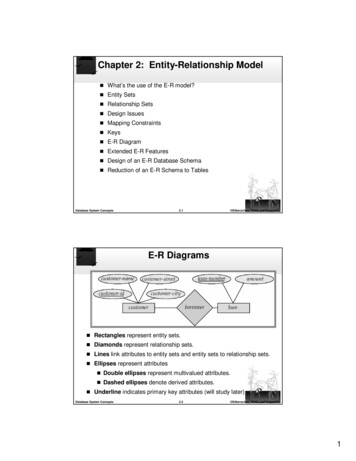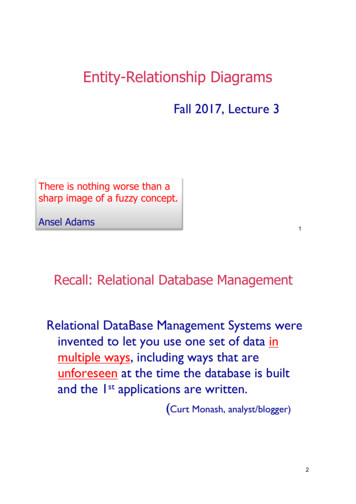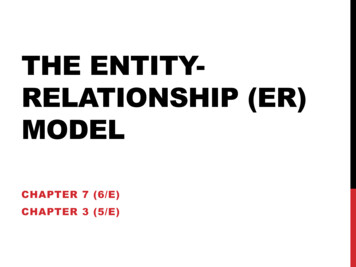
Transcription
Chapter 2: EntityEntity-Relationship Model What’s the use of the E-R model? Entity Sets Relationship Sets Design Issues Mapping Constraints Keys E-R Diagram Extended E-R Features Design of an E-R Database Schema Reduction of an E-R Schema to TablesDatabase System Concepts2.1 Silberschatz, Korth and SudarshanE-R Diagrams Rectangles represent entity sets. Diamonds represent relationship sets. Lines link attributes to entity sets and entity sets to relationship sets. Ellipses represent attributes Double ellipses represent multivalued attributes. Dashed ellipses denote derived attributes. Underline indicates primary key attributes (will study later)Database System Concepts2.2 Silberschatz, Korth and Sudarshan1
Attributes An entity is represented by a set of attributes, that is descriptiveproperties possessed by all members of an entity set.Example:customer (customer-id, customer-name,customer-street, customer-city)loan (loan-number, amount) Domain – the set of permitted values for each attribute Attribute types: Simple and composite attributes. Single-valued and multi-valued attributes E.g.multivalued attribute: phone-numbers Derived attributes Can E.g.be computed from other attributesage, given date of birthDatabase System Concepts2.3 Silberschatz, Korth and SudarshanEntity Sets A database can be modeled as: a collection of entities, relationship among entities. An entity is an object that exists and is distinguishable from otherobjects.Example: specific person, company, event, plant Entities have attributesExample: people have names and addresses An entity set is a set of entities of the same type that share thesame properties.Example: set of all persons, companies, trees, holidaysDatabase System Concepts2.4 Silberschatz, Korth and Sudarshan2
Relationship Sets with AttributesDatabase System Concepts2.5 Silberschatz, Korth and SudarshanE-R Diagram With Composite, Multivalued, andDerived Attributes—Attributes—try to avoid themDatabase System Concepts2.6 Silberschatz, Korth and Sudarshan3
Composite AttributesDatabase System Concepts2.7 Silberschatz, Korth and SudarshanRoles Entity sets of a relationship need not be distinct The labels “manager” and “worker” are called roles; they specify howemployee entities interact via the works-for relationship set. Roles are indicated in E-R diagrams by labeling the lines that connectdiamonds to rectangles. Role labels are optional, and are used to clarify semantics of therelationshipDatabase System Concepts2.8 Silberschatz, Korth and Sudarshan4
Mapping Cardinalities Express the number of entities to which another entity can beassociated via a relationship set. Most useful in describing binary relationship sets. For a binary relationship set the mapping cardinality must beone of the following types: One to one One to many Many to one Many to manyDatabase System Concepts2.9 Silberschatz, Korth and SudarshanMapping CardinalitiesOne to oneOne to manyNote: Some elements in A and B may not be mapped to anyelements in the other setDatabase System Concepts2.10 Silberschatz, Korth and Sudarshan5
Mapping CardinalitiesMany to oneMany to manyNote: Some elements in A and B may not be mapped to anyelements in the other setDatabase System Concepts2.11 Silberschatz, Korth and SudarshanOneOne-ToTo-Many Relationship In the one-to-many relationship a loan is associated with at mostone customer via borrower, a customer is associated withseveral (including 0) loans via borrowerDatabase System Concepts2.12 Silberschatz, Korth and Sudarshan6
ManyMany-ToTo-One Relationships Example of many-to-one relationships: a loan is associated withseveral (including 0) customers via borrower, a customer isassociated with at most one loan via borrowerDatabase System Concepts2.13 Silberschatz, Korth and SudarshanCardinality Constraints We express cardinality constraints by drawing either a directedline ( ), signifying “one,” or an undirected line (—), signifying“many,” between the relationship set and the entity set. Example of One-to-one relationship: A customer is associated with at most one loan via the relationshipborrower A loan is associated with at most one customer via borrowerDatabase System Concepts2.14 Silberschatz, Korth and Sudarshan7
ManyMany-ToTo-Many Relationship Example of Many to Many Relationships: A customer is associated with several (possibly 0) loans viaborrower A loan is associated with several (possibly 0) customers viaborrowerDatabase System Concepts2.15 Silberschatz, Korth and SudarshanAlternative Notation for CardinalityLimits Cardinality limits can also express participation constraintsDatabase System Concepts2.16 Silberschatz, Korth and Sudarshan8
Keys A super key of an entity set is a set of one or more attributeswhose values uniquely determine each entity. A candidate key of an entity set is a minimal super key Customer-id is candidate key of customer account-number is candidate key of account Although several candidate keys may exist, one of thecandidate keys is selected to be the primary key.Database System Concepts2.17 Silberschatz, Korth and SudarshanDegree of a Relationship Set Refers to number of entity sets that participate in a relationshipset. Relationship sets that involve two entity sets are binary (or degreetwo). Generally, most relationship sets in a database system arebinary. Relationship sets may involve more than two entity sets. E.g. Suppose employees of a bank may have jobs (responsibilities)at multiple branches, with different jobs at different branches. Thenthere is a ternary relationship set between entity sets employee, joband branch Relationships between more than two entity sets are not ascommon as binary ones.Database System Concepts2.18 Silberschatz, Korth and Sudarshan9
E-R Diagram with a Ternary RelationshipDatabase System Concepts2.19 Silberschatz, Korth and SudarshanCardinality Constraints on TernaryRelationship We allow at most one arrow out of a ternary (or greater degree)relationship to indicate a cardinality constraint E.g. an arrow from works-on to job indicates each employee workson at most one job at any branch. If there is more than one arrow, there are two ways of defining themeaning. E.g a ternary relationship R between A, B and C with arrows to B and Ccould mean 1. each A entity is associated with a unique entity from B and C or 2. each pair of entities from (A, B) is associated with a unique C entity,and each pair (A, C) is associated with a unique B Each alternative has been used in different formalisms To avoid confusion we outlaw more than one arrowDatabase System Concepts2.20 Silberschatz, Korth and Sudarshan10
Binary Vs. NonNon-Binary Relationships Some relationships that appear to be non-binary may be betterrepresented using binary relationships E.g. A ternary relationship parents, relating a child to his/her father andmother, is best replaced by two binary relationships, father and mother Usingtwo binary relationships allows partial information (e.g. onlymother being know) But there are some relationships that are naturally non-binary E.g.works-onDatabase System Concepts2.21 Silberschatz, Korth and SudarshanWeak Entity Sets An entity set that does not have a primary key is referred to as aweak entity set. The existence of a weak entity set depends on the existence of aidentifying entity set it must relate to the identifying entity set via a total, one-to-manyrelationship set from the identifying to the weak entity set Identifying relationship depicted using a double diamond The discriminator (or partial key) of a weak entity set is the set ofattributes that distinguishes among all the entities of a weakentity set. The primary key of a weak entity set is formed by the primary keyof the strong entity set on which the weak entity set is existencedependent, plus the weak entity set’s discriminator.Database System Concepts2.22 Silberschatz, Korth and Sudarshan11
Weak Entity Sets (Cont.) We depict a weak entity set by double rectangles. We underline the discriminator of a weak entity set with adashed line. payment-number – discriminator of the payment entity set Primary key for payment – (loan-number, payment-number)Database System Concepts2.23 Silberschatz, Korth and SudarshanWeak Entity Sets (Cont.) Note: the primary key of the strong entity set is not explicitlystored with the weak entity set, since it is implicit in theidentifying relationship. If loan-number were explicitly stored, payment could be made astrong entity, but then the relationship between payment andloan would be duplicated by an implicit relationship defined bythe attribute loan-number common to payment and loanDatabase System Concepts2.24 Silberschatz, Korth and Sudarshan12
More Weak Entity Set Examples In a university, a course is a strong entity and a course-offeringcan be modeled as a weak entity The discriminator of course-offering would be semester (includingyear) and section-number (if there is more than one section) If we model course-offering as a strong entity we would modelcourse-number as an attribute.Then the relationship with course would be implicit in the coursenumber attributeDatabase System Concepts2.25 Silberschatz, Korth and SudarshanSpecialization Top-down design process; we designate subgroupings within anentity set that are distinctive from other entities in the set. These subgroupings become lower-level entity sets that haveattributes or participate in relationships that do not apply to thehigher-level entity set. Depicted by a triangle component labeled ISA (E.g. customer “is a”person). Attribute inheritance – a lower-level entity set inherits all theattributes and relationship participation of the higher-level entityset to which it is linked.Database System Concepts2.26 Silberschatz, Korth and Sudarshan13
Specialization ExampleDatabase System Concepts2.27 Silberschatz, Korth and SudarshanGeneralization A bottom-up design process – combine a number of entity setsthat share the same features into a higher-level entity set. Specialization and generalization are simple inversions of eachother; they are represented in an E-R diagram in the same way. The terms specialization and generalization are usedinterchangeably.Database System Concepts2.28 Silberschatz, Korth and Sudarshan14
Specialization and Generalization(Contd.) Can have multiple specializations of an entity set based ondifferent features. E.g. permanent-employee vs. temporary-employee, in addition toofficer vs. secretary vs. teller Each particular employee would be a member of one of permanent-employee or temporary-employee, and also a member of one of officer, secretary, or teller The ISA relationship also referred to as superclass - subclassrelationshipDatabase System Concepts2.29 Silberschatz, Korth and SudarshanDesign Constraints on aSpecialization/Generalization Constraint on which entities can be members of a givenlower-level entity set. condition-defined E.g.all customers over 65 years are members of seniorcitizen entity set; senior-citizen ISA person. user-defined Constraint on whether or not entities may belong to more thanone lower-level entity set within a single generalization. Disjoint anentity can belong to only one lower-level entity setin E-R diagram by writing disjoint next to the ISAtriangle Noted Overlapping anDatabase System Conceptsentity can belong to more than one lower-level entity set2.30 Silberschatz, Korth and Sudarshan15
Design Constraints neralization (Contd.) Completeness constraint -- specifies whether or not an entity inthe higher-level entity set must belong to at least one of thelower-level entity sets within a generalization. total : an entity must belong to one of the lower-level entity sets partial: an entity need not belong to one of the lower-level entitysetsDatabase System Concepts2.31 Silberschatz, Korth and SudarshanAggregation Consider the ternary relationship works-on, which we saw earlier Suppose we want to record managers for tasks performed by anemployee at a branchDatabase System Concepts2.32 Silberschatz, Korth and Sudarshan16
Aggregation (Cont.) Relationship sets works-on and manages represent overlappinginformation Every manages relationship corresponds to a works-on relationship However, some works-on relationships may not correspond to anymanages relationships Sowe can’t discard the works-on relationship Eliminate this redundancy via aggregation Treat relationship as an abstract entity Allows relationships between relationships Abstraction of relationship into new entity Without introducing redundancy, the following diagram represents: An employee works on a particular job at a particular branch An employee, branch, job combination may have an associated managerDatabase System Concepts2.33 Silberschatz, Korth and SudarshanE-R Diagram With AggregationDatabase System Concepts2.34 Silberschatz, Korth and Sudarshan17
E-R Design Decisions The use of an attribute or entity set to represent an object. Whether a real-world concept is best expressed by an entity setor a relationship set. The use of a ternary relationship versus a pair of binaryrelationships. The use of a strong or weak entity set. The use of specialization/generalization – contributes tomodularity in the design. The use of aggregation – can treat the aggregate entity set as asingle unit without concern for the details of its internal structure.Database System Concepts2.35 Silberschatz, Korth and SudarshanE-R Diagram for a Banking EnterpriseDatabase System Concepts2.36 Silberschatz, Korth and Sudarshan18
Summary of Symbols Used in EE-RNotationDatabase System Concepts2.37 Silberschatz, Korth and SudarshanSummary of Symbols (Cont.)Database System Concepts2.38 Silberschatz, Korth and Sudarshan19
Alternative EE-R NotationsDatabase System Concepts2.39 Silberschatz, Korth and SudarshanReduction of an EE-R Schema to Tables1. A database which conforms to an E-R diagram can berepresented by a collection of tables2. For each (strong) entity set there is a table having ascandidate key the key of the entity set3. For relationship set there is a table having as columnsthe keys of the participating entities. The candidate keyfor the table is determined by the cardinality constraintsamong participating entities.4. A weak entity set becomes a table that includes a columnfor the primary key of the identifying strong entity set5. Inheritance to be discussed later Database System Concepts2.40 Silberschatz, Korth and Sudarshan20
ManyMany-ToTo-One Relationships Example of many-to-one relationships: a loan is associated withseveral (including 0) customers via borrower, a customer isassociated with at most one loan via borrowerDatabase System Concepts2.41 Silberschatz, Korth and SudarshanRepresenting Entity Sets as Tables A strong entity set reduces to a table with the same attributes.Database System Concepts2.42 Silberschatz, Korth and Sudarshan21
Representing Relationship Sets asTables A many-to-many relationship set is represented as a table withcolumns for the primary keys of the two participating entity sets,and any descriptive attributes of the relationship set. E.g.: table for relationship set borrowerDatabase System Concepts2.43 Silberschatz, Korth and SudarshanRedundancy of Tables Table with equivalent keys can be merged together---asin the 3NF design algorithm E.g.: Merge the tables account-branch with accountDatabase System Concepts2.44 Silberschatz, Korth and Sudarshan22
Redundancy of Tables (Cont.) For one-to-one relationship sets, either side can be chosento act as the “many” side That is, extra attribute can be added to either of the tablescorresponding to the two entity sets If participation is partial on the many side null valuesmight be neededDatabase System Concepts2.45 Silberschatz, Korth and SudarshanComposite and Multivalued Attributes Previous rules hold for simple attributes Composite attributes are flattened out by creating a separate attributefor each component attribute E.g. given entity set customer with composite attribute name withcomponent attributes first-name and last-name the table correspondingto the entity set has two attributesname.first-name and name.last-nameDatabase System Concepts2.46 Silberschatz, Korth and Sudarshan23
Representing Weak Entity Sets A weak entity set becomes a table that includes a column forthe primary key of the identifying strong entity set:Database System Concepts2.47 Silberschatz, Korth and SudarshanRepresenting Specialization as Tables Method 1: Form a table for the higher level entity Form a table for each lower level entity set, include primary key ofhigher level entity set and local attributestablepersoncustomeremployeetable attributesname, street, cityname, credit-ratingname, salary Drawback: getting information about, e.g., employee requiresaccessing two tablesDatabase System Concepts2.48 Silberschatz, Korth and Sudarshan24
Representing Specialization as Tables(Cont.) Method 2: Form a table for each entity set with all local and e attributesname, street, cityname, street, city, credit-ratingname, street, city, salaryIf specialization is total, no need to create table for generalizedentity (person) Drawback: street and city may be stored redundantly for personswho are both customers and employeesDatabase System Concepts2.49 Silberschatz, Korth and SudarshanRelations Corresponding toAggregation To represent aggregation, create a table containing primary key of the aggregated relationship, the primary key of the associated entity set Any descriptive attributesDatabase System Concepts2.50 Silberschatz, Korth and Sudarshan25
Relations Corresponding toAggregation (Cont.) E.g. to represent aggregation manages between relationshipworks-on and entity set manager, create a tablemanages(employee-id, branch-name, title, manager-name) Table works-on is redundant provided we are willing to storenull values for attribute manager-name in table managesDatabase System Concepts2.51 Silberschatz, Korth and SudarshanEnd of Chapter 226
two). Generally, most relationship sets in a database system are binary. Relationship sets may involve more than two entity sets. E.g. Suppose employees of a bank may have jobs (responsibilities) at multiple branches, with different jobs at different branches. Then there is a ternary relationship set between entity sets employee, job and branch










